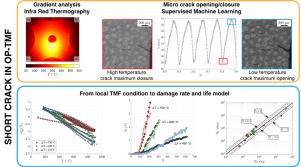Short fatigue crack growth sensitivity to thermo-mechanical fatigue loading
IF 5.7
2区 材料科学
Q1 ENGINEERING, MECHANICAL
引用次数: 0
Abstract
Most high-temperature components are subject to out-of-phase thermomechanical fatigue (OP-TMF), which induces crack growth at low temperatures. However, OP-TMF has been little studied in the context of short cracks. This study focuses on the experimental sensitivity of OP-TMF loading conditions playing on temperature range, gradient, and dwell time for thin sheet superalloy specimens. The material of interest is a Co-based superalloy, HA188. It is widely used in combustion chambers.
The experimental analysis is based on full-field measurements for temperature, strain and damage by infrared thermography, digital image correlation and high resolution images from 300 to 900 °C. The main conclusion is that the temperature gradient, together with the temperature amplitude, largely determines the strain amplitude and subsequent fatigue crack growth rate (FCGR) of short cracks. In situ measurements of damage and crack closure were obtained using supervised machine learning based on images. This clarifies that crack closure is only partial and that the crack network growth rate is consistent with the individual short crack growth rate. Finally, 3D finite element analysis considering realistic temperature field and strain energy based FCGR model was able to evaluate the fatigue life in this context. It is shown that the OP-TMF FCGR is very close to the FCGR of the maximum temperature of the TMF cycle due to partial crack closure.

短疲劳裂纹增长对热机械疲劳加载的敏感性
大多数高温部件都会受到相外热机械疲劳(OP-TMF)的影响,这种疲劳会导致裂纹在低温下生长。然而,针对短裂纹的 OP-TMF 研究却很少。本研究的重点是薄板超合金试样的 OP-TMF 加载条件对温度范围、梯度和停留时间的实验敏感性。研究材料是一种钴基超级合金 HA188。实验分析基于红外热成像、数字图像相关和 300 至 900 °C 高分辨率图像对温度、应变和损伤的全场测量。主要结论是温度梯度和温度振幅在很大程度上决定了应变振幅和随后短裂纹的疲劳裂纹生长率(FCGR)。通过基于图像的监督机器学习,获得了损伤和裂纹闭合的现场测量结果。这说明裂纹闭合只是部分的,裂纹网络增长率与单个短裂纹增长率是一致的。最后,考虑到现实温度场和基于应变能的 FCGR 模型的三维有限元分析能够评估这种情况下的疲劳寿命。结果表明,由于部分裂纹闭合,OP-TMF FCGR 与 TMF 循环最高温度的 FCGR 非常接近。
本文章由计算机程序翻译,如有差异,请以英文原文为准。
求助全文
约1分钟内获得全文
求助全文
来源期刊

International Journal of Fatigue
工程技术-材料科学:综合
CiteScore
10.70
自引率
21.70%
发文量
619
审稿时长
58 days
期刊介绍:
Typical subjects discussed in International Journal of Fatigue address:
Novel fatigue testing and characterization methods (new kinds of fatigue tests, critical evaluation of existing methods, in situ measurement of fatigue degradation, non-contact field measurements)
Multiaxial fatigue and complex loading effects of materials and structures, exploring state-of-the-art concepts in degradation under cyclic loading
Fatigue in the very high cycle regime, including failure mode transitions from surface to subsurface, effects of surface treatment, processing, and loading conditions
Modeling (including degradation processes and related driving forces, multiscale/multi-resolution methods, computational hierarchical and concurrent methods for coupled component and material responses, novel methods for notch root analysis, fracture mechanics, damage mechanics, crack growth kinetics, life prediction and durability, and prediction of stochastic fatigue behavior reflecting microstructure and service conditions)
Models for early stages of fatigue crack formation and growth that explicitly consider microstructure and relevant materials science aspects
Understanding the influence or manufacturing and processing route on fatigue degradation, and embedding this understanding in more predictive schemes for mitigation and design against fatigue
Prognosis and damage state awareness (including sensors, monitoring, methodology, interactive control, accelerated methods, data interpretation)
Applications of technologies associated with fatigue and their implications for structural integrity and reliability. This includes issues related to design, operation and maintenance, i.e., life cycle engineering
Smart materials and structures that can sense and mitigate fatigue degradation
Fatigue of devices and structures at small scales, including effects of process route and surfaces/interfaces.
 求助内容:
求助内容: 应助结果提醒方式:
应助结果提醒方式:


